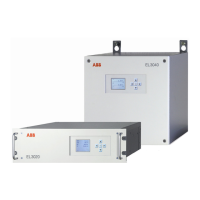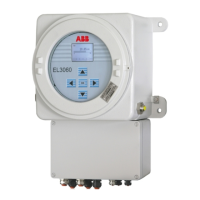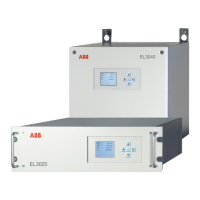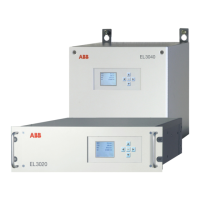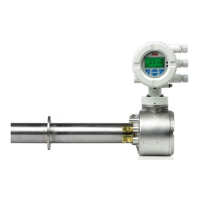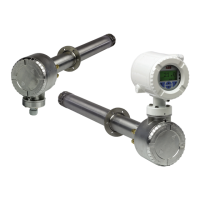106 EL3000 CONTINUOUS GAS ANALYZERS | CI/EL3000-EN REV. C
… 6 Commissioning
… Check the integrity of combustion gas path
Combustion gas supply from a central unit
1. Switch off the gas analyzer power supply. Ensure that the
shut-off valve in the combustion gas supply line is open.
2. Set the combustion gas pressure at 1.1 x the normal pressure
of the combustion gas, i.e. at approx. 1.4 bar.
3. Mark pressure indication on the manometer of the pressure
reducer.
4. Shut off the combustion gas supply.
5. Observe the display on the manometer – it should not change
measurably in 10 minutes.
• A measurable change in the display is an indication of a
leak in the combustion gas path between the pressure
reducer and the combustion gas inlet valve of the gas
analyzer.
In this case the following measures are to be taken:
– Check the combustion gas line between the pressure
reducer and gas analyzer with a leak detection spray.
A leak in this area must be remedied and another leak
test must be performed before the gas analyzer is put
into operation again.
– If no leak is found, that means the gas analyzer
combustion gas inlet valve is leaky.
Explosion hazard
Explosion hazard if there is a leak in the combustion gas inlet
valve.
If a leak is detected at the combustion gas inlet valve:
• Disconnect the combustion gas supply.
• Do not restart the gas analyzer.
• Have the combustion gas valve replaced by the ABB
6. After conclusion of the seal integrity test, set the combustion
gas pressure to normal pressure again, i.e. 1.2 bar.
Combustion gas path in the gas analyzer
1. The gas analyzer must be in operation (flame on).
2. Inspection of combustion gas feed path with positive
pressure (combustion gas inlet to combustion gas nozzle):
• Check all connection points with a hydrogen detector
(for example, based on thermal conductivity) for leakage
of combustion gas.
– The leakage rate may not up-scale 10
-4
hPa l/s.
3. Inspection of the combustion gas feed path with negative
pressure (in the detector, after the combustion gas nozzle):
• Connect zero gas at the sample gas inlet.
• Shroud all joints successively with a small cloud of a gas
that contains hydrocarbons (e.g. with a cold spray or a
test gas that contains hydrocarbons, or a cloth soaked in
acetone).
– Observe the measured value display; if the measured
value changes to a positive value, the relevant
connection is leaking.
